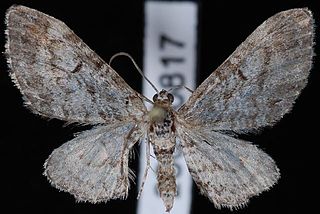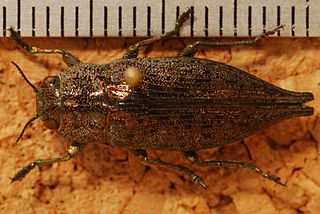Related Research Articles

Entomology is the scientific study of insects, a branch of zoology. In the past the term "insect" was less specific, and historically the definition of entomology would also include the study of animals in other arthropod groups, such as arachnids, myriapods, and crustaceans. This wider meaning may still be encountered in informal use.

Schinia, commonly called flower moths, is a large genus of moths belonging to the family Noctuidae. The genus has a Holarctic distribution with the vast majority of species being found in North America, many with a very restricted range and larval food plant.

The American elm cultivar Ulmus americana 'Brandon' was raised by Lacombe Nurseries Lacombe, Alberta, Canada, before 1969; it may be synonymous with another cultivar from the same source known as 'Patmore', selected and raised by R. H. Patmore from a native tree in Brandon, Manitoba.
Catocala parta, the mother underwing, is a moth of the family Erebidae. The species was first described by Achille Guenée in 1852. It is found in North America from Nova Scotia south to Maryland and Kentucky, west to southern Saskatchewan and Alberta, western Montana, and Utah. The wingspan is 70–78 mm. Adults are on wing from August to September depending on the location.
Catocala meskei, or Meske's underwing, is a moth of the family Erebidae. The species was first described by Augustus Radcliffe Grote in 1873. It is found in North America from Maine and Quebec west to southern Alberta and Montana, south to South Carolina in the east and at least Montana in the west.
Catocala hermia, the Hermia underwing, is a moth of the family Erebidae. The species was first described by Henry Edwards in 1880. It is found throughout the Great Plains of North America, from southern Saskatchewan and Alberta south and west to Texas, Arizona and California.

Actebia fennica, the black army cutworm or Eversmann's rustic, is a moth of the family Noctuidae. The species was first described by August Michael Tauscher in 1806. It has a Holarctic distribution from Newfoundland through western Europe, Siberia, the Far East, Mongolia, northern China to Korea and Japan. In North America it is mainly found in the boreal region, south to New England, southern Montana and northern Oregon.
Agrochola verberata is a moth in the family Noctuidae first described by Smith in 1904. It is found in western North America, from south-central Saskatchewan west to Alaska and coastal British Columbia, south to at least south-western Montana and south-western Colorado.
Caenurgina annexa, the banded grass moth, is a moth of the family Erebidae. The species was described by Henry Edwards in 1890. It is found in western North America from western Alberta and Montana to British Columbia, Washington, and Oregon.
Euxoa clausa is a moth of the family Noctuidae first described by James Halliday McDunnough in 1923. It is known in North America mainly from the north-western Great Plains in southern Saskatchewan and Alberta, south to south-western Montana and Nebraska.

Dicerca is a genus of beetles in the family Buprestidae. It contains the following species:

Dioryctria ponderosae, the ponderosa twig moth, is a moth of the family Pyralidae. The species was first described by Harrison Gray Dyar Jr. in 1914. It is found in North America from Washington and Montana south to California and northern Mexico.

Eupithecia graefi, or Graef's pug, is a moth in the family Geometridae. The species was first described by George Duryea Hulst in 1896. It is found in North America from south-western Alberta west to Vancouver Island, north to Alaska and south to California. The habitat consists of wooded areas.

Calopteryx aequabilis, the river jewelwing, is a species of broad-winged damselfly. The species was first described by Say in 1839. It is one out of the 170 species of the Odonata found from northeastern Alberta to Newfoundland and south in most of the United States.
Grammia doris, the Doris tiger moth, is a moth of the family Erebidae. It was described by Jean Baptiste Boisduval in 1869. It is found in North America from British Columbia, northern Idaho, Alberta and western Montana. In the east, it is found in the Atlantic Coast provinces and from Nova Scotia to northern Florida and west to central Texas. The habitat consists of open willow/sedge fens and probably other open wetlands in the boreal forest.

Eana argentana is a moth of the family Tortricidae. It is found in Great Britain, Spain, France, Luxembourg, Belgium, the Netherlands, Germany, Austria, Switzerland, Italy, the Czech Republic, Slovakia, Poland, Albania, Bosnia and Herzegovina, Slovenia, Hungary, Bulgaria, Romania, North Macedonia, Greece, Norway, Sweden, Finland, the Baltic region and Russia. It is also present in western North America, where it has been recorded from Alaska, Alberta, Arizona, British Columbia, California, Maine, Montana, New Mexico, Washington and Wyoming. The habitat consists of high-elevation open habitats.

Dicerca divaricata, also known as the flatheaded hardwood borer, is a species of black coloured beetle from subfamily Chrysochroinae found in North America. It is 15–22 millimetres (0.59–0.87 in) long. The species is known for feeding on various maples such as Acer saccharum and Acer rubrum as well as Ulmus americana and Cercis species. The species fly in June.
Dicerca lugubris is a species of beetle from the subfamily Chrysochroinae first described by John Lawrence LeConte in 1860. It is dark-cupreous coloured on top and black-cupreous below. The length of the species may vary from 11.1–16.5 millimetres (0.44–0.65 in) while they can be as wide as 4.1–6.0 millimetres (0.16–0.24 in). The species can be found on Lake Superior, Marquette, Michigan as well as Laniel, Quebec. It is also found in Iowa, Alberta, and southeastern North America where it feeds on jack pine.
Dicerca tenebrica, the flatheaded wood borer or flatheaded poplar borer, is a brassy to black coloured beetle from Chrysochroinae subfamily which can be found in Canada and both Southern and Northeastern United States. The species was first described by William Kirby in 1837.
Dicerca lepida, the embossed hawthorn buprestid, is a species of metallic wood-boring beetle in the family Buprestidae. It is found in North America.
References
- 1 2 "Species Page - Dicerca pectorosa". Entomology Collection. University of Alberta E.H. Strickland Entomological Museum. Archived from the original on February 17, 2015. Retrieved February 17, 2015.
- ↑ "Montana Wood Boring Insect Project". Montana State University. Archived from the original on February 17, 2015. Retrieved February 17, 2015.